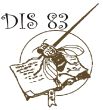
Das, Arpan, and Jayanta Kundu. 2000. ROOMI Technique - a novel staining technique. Dros. Inf. Serv. 83: 190-191.
|
|
|
|||
|
|
||||
ROOMI Technique - a novel staining technique.
Das, Arpan, and Jayanta Kundu. Department of Zoology, Vidyasagar University, Midnapur - 721102, West Bengal, India.
For histological study of testis and ovary of Drosophila, tissue sections were stained with haematoxylin and eosin by various workers. Such histological study was obviously a very lengthy process. On the other hand, squash preparation is a rather fast process to examine the contents of testis and ovary of Drosophila, but such preparation can not be well observed under a light microscope. Instead, it needs phase contrast or electron microscopy, as observed by Kemphues et al. (1980), Castrillion et al. (1993), and others.
ROOMI (Rapid Oogenesis Mutation Identification) technique, developed in our laboratory, is a rapid and easy method by which squash preparation of soft tissues like testis and ovary of
 |
| Figure 1. Squash preparation of ovary of Drosophila. Wild type (a) and sterile (b) ovaries treated only with aceto orcein. The same slides (c and d) after treating also with Toluidine Blue. |
Drosophila can be stained in a short time and visualized better under a light microscope. The stage at which gametogenesis is affected by mutation can be promptly identified by this technique.
Staining Protocol:
i) Testis or ovary was kept on a glass slide with a drop of Ringer's solution.
ii) Ringer's solution was drained out immediately and a few drops of fixative [aceto-alcohol (1:3)] were added to the tissue.
iii) Fixative was also drained out immediately and a few drops of aceto-orcein were added to it. The slide was kept covered with a petri dish for 20 minutes.
iv) Excess aceto-orcein was drained out and the tissue was washed with 50% acetic acid.
v) Finally a drop of 50% acetic acid was put on the tissue, a coverslip was gently placed above it, the coverslip was wrapped with filter paper and pressed gently.
vi) Now a drop of 0.5% Toluidine Blue was put at an edge of the coverslip and the preparation was kept undisturbed until the Toluidine Blue had diffused into the space in between the slide and coverslip. As soon as the Toluidine Blue covered the space totally, it was sucked up by the filter paper.
vii) The edges of the coverslip may be sealed with DPX.
viii) The slide was then observed under the
light microscope.
Conventional squash preparation with aceto-orcein is not clearly observed under the light microscope (Figures 1a and 1b), but when this slide is treated also with Toluidine Blue (0.5%), it is well observed under the light microscope (Figures 1c and 1d). Squash preparation only with Toluidine Blue is not well observed. A further biochemical study is needed for whether there is a chemical reaction between aceto-orcein (weak acid) and Toluidine Blue (basic dye) to form a violet substance which is responsible for such better view.
References: Castrillion, D.H., P. Gonczy, S. Alexander, R. Rawson, C.G. Eberhart, S. Viswanathan, S. DiNardo, and S.A. Wasserman 1993, Genetics 135: 489-505; Kemphues, K.J., R.A. Raff, and T.C. Kaufman 1980, Cell 21: 445-451.